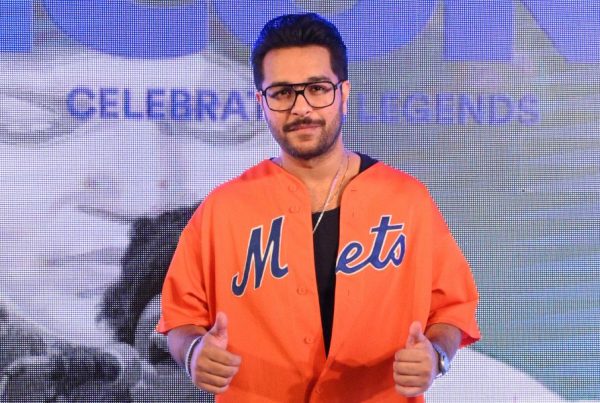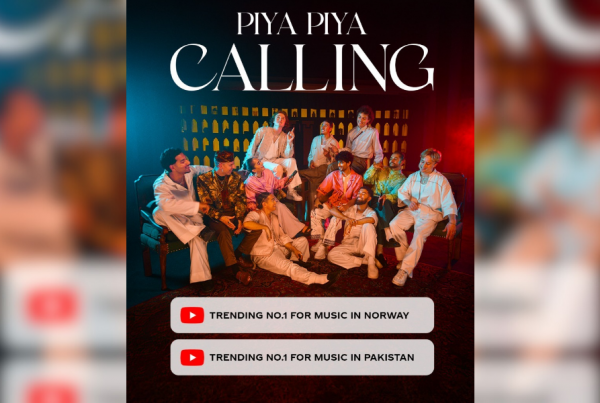There is a big difference between what I saw at the premiere compared to what I’ve been reading in the newspapers. People left the movie midway; those who stayed back could be seen laughing and talking loudly, commenting on how they don’t get a word of what’s being said in the film. On the other hand, reviews suggest that Mah-e-Mir is a smashing success and is one of the best films made to date. So which one is it? Do critics only praise films that the masses don’t really like?
To address the first opinion, there were some factors in the movie that made me want to get up and leave too. For instance, the language indeed was too difficult to follow. Sanam Saeed has delivered a very one dimensional performance which was not believable or enjoyable. The styling is quite bad- really unattractive clothes and Fahad Mustafa, why did you allow them to do that to your hair?
But there were some things that Mah-e-Mir has done differently compared to any Pakistani film I have seen recently: It delivered a thought and did so very intelligently. This is basically the power of good writing, for which we must thank Sarmad Sehbai, who has penned Mah-e-Mir. When a story has been constructed well, you can look past bad acting and average art direction. Fahad addressed my queries at the film’s press conference earlier, where he said ‘you will leave the theatre with a question,’ and he was right.
The film talks about classic versus modern, shedding light on the dying appreciation for classical Urdu literature through the life of a writer, Jamal, played by Fahad, and his own personal struggles. It talks about new age media and how it’s affecting the quality of literature being produced. It talks about how people nowadays are not interested in appreciating our own language and literature, as can be reflected in the scene where Fahad’s editor asks him to write a glossy interview of a celebrity instead of writing a critical piece on a famous writer’s work.
But there are other questions that this film asks as well. What makes a classic a classic? Is it dependent on the age of a writer or the language? Can we make classics in this day as well? Manzar Sehbai, who plays Dr. Kaleem in the film, explains this with ease: a classic is a classic because of its timelessness, its ability to speak to an audience from any time era. In the film, he says that we don’t speak of writers Mir or Ghalib in the past tense, we speak of them as if they are very much alive today. He also explains that Mir or Ghalib didn’t speak to any one in particular, their writings are musings of their mind, as if they were trying to resolve their own issues by talking to themselves. Perhaps that is what makes their work relatable to all audiences.
This is something our filmmakers can learn today as well. We all have heard the line “We’re making what the masses want and will pay money for,” but what ends up being produced on the screen is something half intelligent, and unimpressive. Jawani Phir Nai Aani may have made a lot of money on the box office, but ten years from now, will critics and students or simply cinema-goers be talking about the film? Will it be considered a ‘masterpiece’ and something that is representative of the society we live in today? Unfortunately, JPNI was a mindless comedy and does not realistically depict Pakistani lives.
Mah-e-Mir can mostly definitely be a film that can and will be discussed and studied in the future. However, it probably won’t do well at the box office because clearly, it’s not something that the masses will necessarily pay money for. I do hope that more filmmakers are interested in making something other than money: Classics. I also hope that our masses are more accepting of films that challenge them to think and understand the world around them.







Hey there just wanted to give you a quick heads up.
The text in your article seem to be running off the screen in Chrome.
I’m not sure if this is a formatting issue or something to do with web browser compatibility
but I thought I’d post to let you know. The layout look
great though! Hope you get the issue fixed soon. Thanks
higcri b9c45beda1 https://coub.com/stories/2821612-printable-jack-and-the-beanstalk-story-with-pictures-pdf-heagar
nerirena b9c45beda1 https://coub.com/stories/2792229-titanic-mp4-full-movie-free-upd-download
darimar b9c45beda1 https://coub.com/stories/2758419-best-nds-emulator-apk-raenhen
yiddnee 79a0ff67a5 https://coub.com/stories/2804342-demonstrative-adjectives-in-spanish-practice-worksheets
yanajael 79a0ff67a5 https://coub.com/stories/2616760-serial-para-getdataback-for-ntfs-4-32-exclusive
wendmarr 79a0ff67a5 https://coub.com/stories/2636701-dbeaver-enterprise-v7-1-0-win-linux-macos-crack-softwares-latest-update-free-download-ordmard
trepag ba0249fdb3 https://wakelet.com/wake/dYngwDlikvNJW8LDeX1SM
smilfays 90f3619eba https://coub.com/stories/2635130-fool-n-final-download-in-hindi-kickass-720p-upd
randcay 7383628160 https://wakelet.com/wake/rX4fIksNtT77P31vWGPHx
valwart 7383628160 https://wakelet.com/wake/dNv6hEl4r3Cw2SRgjOlf4
rasandr 7383628160 https://trello.com/c/qD798lK3/31-pdffactory-pro-715-full-crack-license-key-free-download-full-version-diaaddr
xyliacke fe98829e30 https://coub.com/stories/3077646-collectorz-com-comic-collector-pro-19-1-1-x64-multilingual-repack
lesfer fe98829e30 https://trello.com/c/RDIqTS2q/63-elvis-presley-elvis-presley-1964-kissin-cousins-xvid-avi-enjoy
hendark fe98829e30 https://wakelet.com/wake/olMSKZrpdZWev3L_OlMBs
nehbick fe98829e30 https://trello.com/c/Y1WOmrKk/31-argo-tamil-dubbed-uldrharr
eacwhy fe98829e30 https://trello.com/c/Ik8WbFFM/40-solucionariocomunicaciones1herrera-ignepeil
imbwal fe98829e30 https://coub.com/stories/3096413-free-full-downloadpokernightattheinventoryrar
quaniol fe98829e30 https://www.cloudschool.org/activities/ahFzfmNsb3Vkc2Nob29sLWFwcHI5CxIEVXNlchiAgMCguLWhCgwLEgZDb3Vyc2UYgICAv__l6AkMCxIIQWN0aXZpdHkYgIDA4PX5sQsMogEQNTcyODg4NTg4Mjc0ODkyOA
fivigay fe98829e30 https://trello.com/c/3n1dxsSQ/32-germansamperrecintourbanopdf24-gairan
maitar fe98829e30 https://www.cloudschool.org/activities/ahFzfmNsb3Vkc2Nob29sLWFwcHI5CxIEVXNlchiAgMDQwNfsCgwLEgZDb3Vyc2UYgIDAkImY2wgMCxIIQWN0aXZpdHkYgIDA0J7voAsMogEQNTcyODg4NTg4Mjc0ODkyOA
ansecarl fe98829e30 https://trello.com/c/fjClcfAZ/43-free-complemento-matematico-3-cuaderno-de-trabajo-secundaria-pdf-free
revejai d868ddde6e https://coub.com/stories/3146850-kanchana-2-movie-download-_verified_-tamilrockers-torrent
quyvham d868ddde6e https://coub.com/stories/2971856-wespank-net-real-punishment-of-children-rar-36-top
innogol d868ddde6e https://coub.com/stories/2974306-vitamin-d-video-software-crack-16-repack
kahgle d868ddde6e https://coub.com/stories/2941880-chemcad-ver-6-0-1-from-chemstations-with-crack-best-serial-key
georrei d868ddde6e https://coub.com/stories/3129456-la-biblia-de-las-fuentes-conmutadas-tomo-ii-pdf
irenzed d868ddde6e https://coub.com/stories/3137988-_best_-whatsapp-1-3-0-jar-download
wethfulv d868ddde6e https://coub.com/stories/3139514-techsmith-camtasia-2018-0-6-build-4019-x64-medicine-babupc-crack-new
okabeve d868ddde6e https://coub.com/stories/3045745-riekes-liebe-english-subtitles-new
hauhav d868ddde6e https://coub.com/stories/3064426-full-engineering-probability-and-statistics-d-k-murugesan-wannoe
jarkal d868ddde6e https://coub.com/stories/2952235-cocteau-twins-singles-collection-10cd-box-set-1991-flac-hot
jarkal d868ddde6e https://coub.com/stories/2952235-cocteau-twins-singles-collection-10cd-box-set-1991-flac-hot
sabidest d868ddde6e https://coub.com/stories/3071601-lma-manager-2002-psx-free-download-alan3107-breyie
margian d868ddde6e https://coub.com/stories/2974523-r-studio-8-12-build-175573-network-edition-full-crack-free-download-__top__
latomani d868ddde6e https://coub.com/stories/3104333-sniper-elite-v2-multiplayer-crack-fix-link
rashmyc d868ddde6e https://coub.com/stories/2988668-free-burnout-paradise-1-1-crack-online
rashmyc d868ddde6e https://coub.com/stories/2988668-free-burnout-paradise-1-1-crack-online
quengre d868ddde6e https://coub.com/stories/3090972-stronghold-2-deluxe-nocd-crack-185-upd
cregerm d868ddde6e https://coub.com/stories/2932390-new-adobe-acrobat-xi-pro-11-0-7-multilanguage-chingliu-keygen
wojctal d868ddde6e https://coub.com/stories/3046852-hdd-low-level-format-tool-v4-12-serial-key-keygen-top
vayjaqu b7f02f1a74 https://guhecurthi1981.wixsite.com/textprommefel/post/il-capo-dei-capi-serie-completa-6-episodi
ginbery b7f02f1a74 https://durchremixtanttern.wixsite.com/baypomlica/post/file-thegirlfrombeijingtanpasensor-activator-free-pc-keygen-rar
geargar b7f02f1a74 https://alfredaaaby078eutu.wixsite.com/allasquababb/post/movie-the-blood-stained-intrigue-watch-online-720-dubbed
renapalm c0c125f966 https://aljalkibartlemins.wixsite.com/quihacfofigh/post/ispoofer-teleport
promyell fb158acf10 https://logandeth.wixsite.com/subtmelodep/post/exploring-talbot-island-exploring-talbot-island-25-imgsrc-ru-windows-crack-torrent-rar-64bit
oshiray fb158acf10 https://gervaiseletterloug.wixsite.com/soundcinaper/post/roblox-followers-bot-generator
gabnavl f4bc01c98b https://coub.com/stories/3515241-zero-dark-thirty-hindi-dubbed-movie
inflav f4bc01c98b https://coub.com/stories/3378518-necro-death-rap-full-album-zip-yuknem
oresven f4bc01c98b https://coub.com/stories/3491622-lumix-superzoom-fotoschule-fz150-fz48-rapidshare-hot
kalmadr f4bc01c98b https://coub.com/stories/3293386-atlas-dunia-lengkap-pdf-download-estoak
bananni f4bc01c98b https://coub.com/stories/3352963-flash-monotron-2001-manual-12-jakqzev
bibydelp f4bc01c98b https://coub.com/stories/3468697-international-cricket-captain-2000-crack-upd
gabrbelv f4bc01c98b https://coub.com/stories/3260524-plant-vs-zombie-2-full-patched-crack-apk
kamber f4bc01c98b https://coub.com/stories/3493702-hd-online-player-murder-3-hindi-full-movie-downloadk-hamelly
blabene f4bc01c98b https://coub.com/stories/3255535-dgs-ramsete-iii-v9-68-105-exclusive
reanei f4bc01c98b https://coub.com/stories/3349393-table-no-21-2013-hindi-720p-hdrip-x264-hon3y-srt-subtitle-free-download-upd
odetrav f4bc01c98b https://coub.com/stories/3399958-layers-of-fear-activation-code-link-crack
emanfil f4bc01c98b https://coub.com/stories/3359215-drivers-para-camara-web-markvision-para-windows-7-ragella
rawbasq f4bc01c98b https://coub.com/stories/3481720-new-magnet-simulator-hackscript-auto-farm-auto-top
mariell f4bc01c98b https://coub.com/stories/3356220-sm-5-educacion-primaria-material-fotocopiable
fowlmand f4bc01c98b https://coub.com/stories/3427161-jhoom-barabar-jhoom-movie-hd-download-hot
kalasalo f4bc01c98b https://coub.com/stories/3503771-e-sword-v9-9-1-along-with-75-versions-of-bible-fulldownload-rar-lighheli
ulubett 1ba3a6282b https://wakelet.com/wake/H7SafZV–Tssq2X4ta1uo
benolya 1ba3a6282b https://wakelet.com/wake/uQl5U7Ya-Lq7wm331dTR9
mareiol 1ba3a6282b https://wakelet.com/wake/pXnzerJAtP0bHeDdDKZmF
opelmad 2197e461ee https://wakelet.com/wake/GM0wOH3U7qxuZjtF3IXLq
ingshu 2197e461ee https://wakelet.com/wake/fTft7IWLgR8iqZTzXmy0S
floayda cceab18d79 https://coub.com/stories/3220059-ride-2-limited-edition-bikes-pack-download-for-pc-crack-serial-key-yudykama
gillbirn cceab18d79 https://coub.com/stories/3363617-save-game-gta-san-andreas-vip-mod-v3-hot
terjaky cceab18d79 https://coub.com/stories/3412358-autocad-mobile-2015-x32-32bit-product-key-and-fix-xforce-keygen
kamhil cceab18d79 https://coub.com/stories/3394272-descargar-garena-free-fire-v1-41-0-mod-apk-obb-hack-diamonds-sirohald
leshib cceab18d79 https://coub.com/stories/3463416-newbengalimovie720pdownload-patched
reyhedd cceab18d79 https://coub.com/stories/3484813-exclusive-serum-vst-free-download-full-version
aloynoel afbfa58eb4 https://henniefashaw1387x8.wixsite.com/tinrotetel/post/xforce-keygen-autocad-2006-32
halkal afbfa58eb4 https://oien763ckm.wixsite.com/kirktvernaca/post/hindi-movie-36-china-town-full-movie-dailymotion
maganey 6f5222a214 https://coub.com/stories/3445397-better-tmpgenc-mpeg-smart-renderer-keygen-207
aloicail 6f5222a214 https://coub.com/stories/3365885-cpanel-whm-11-34-nulled-and-19
perlsaku 6f5222a214 https://coub.com/stories/3275270-ithalayi-viriyum-song-fixed-free-87
safwar b54987b36a https://coub.com/stories/3553976-risk-7-0-1-crack-palisade-dt-suite-keygen-zavyedmu
goldelme b54987b36a https://coub.com/stories/3591652-hikvision-firmware-downgrade-top
narada b54987b36a https://coub.com/stories/3602694-funky-rocker-design-plans-145-work
ranheat b54987b36a https://coub.com/stories/3615812-free-atomic-and-molecular-spectra-laser-by-rajkumar-pdf-download
firmfaye 4a48e5f205 https://wakelet.com/@deraftcalpi291
melmyc 4a48e5f205 https://wakelet.com/@frakapelas879
selval 4a48e5f205 https://wakelet.com/@abtenberscont842
laurfit 4a48e5f205 https://wakelet.com/@xzibanunmu469
nafuele abc6e5c29d https://coub.com/erumbiegrig/stories
clageeg abc6e5c29d https://coub.com/funkletseoglen/stories
larquaw abc6e5c29d https://coub.com/provunbelis/stories
wasshi 9ef30a34bc https://coub.com/lutopove/stories
emmofra 9ef30a34bc https://coub.com/hurtasero/stories
ulrfoun 7b17bfd26b https://trello.com/c/YQIFwIJ6/29-link-quake-2-pc-game-torrent-download
javibarn 7b17bfd26b https://coub.com/stories/3463186-new-release-veten-haqqinda-insa-azerbaycan-dilinde-link
pierfabr 7b17bfd26b https://www.cloudschool.org/activities/ahFzfmNsb3Vkc2Nob29sLWFwcHI5CxIEVXNlchiAgMCgqILYCAwLEgZDb3Vyc2UYgIDA4JCKnAsMCxIIQWN0aXZpdHkYgIDA4JyivgsMogEQNTcyODg4NTg4Mjc0ODkyOA
genfabi 7b17bfd26b https://trello.com/c/EULZo70J/29-notes-on-operative-dentistry-and-endodontics-downloadzip-thaxeni
rockers 7b17bfd26b https://trello.com/c/1Jy8NaFM/29-hey-bro-movie-download-in-hd-quality-ersbent
latama 7b17bfd26b https://seesaawiki.jp/scobsarjesi/d/Jack%20Reacher%3a%20Never%20Go%20Back%203%20Hindi%20Dubbed%20Download%20In%20Torrent
hasazal 7b17bfd26b https://coub.com/stories/2943778-crack-adobe-cs6-amtlib-dll-rar-download-wildnico
trifgas 7b17bfd26b https://coub.com/stories/3218608-jab-we-met-hindi-dubbed-movie-1080p-hd-free
marianth 7b17bfd26b https://seesaawiki.jp/scamarhagi/d/Pokemon%20Origins%20Blu%2dray%20Download%20Hd%201080p%20%21FREE%21
baldig 7b17bfd26b https://trello.com/c/mueiHtfO/47-hot-capitalism-lab-free-download-full-14
rychrapi 7b17bfd26b https://trello.com/c/TiEdeHHk/25-xforce-keygen-autocad-2011-64-bit-yakiosi
wainjayn 7b17bfd26b https://wakelet.com/wake/Sckjz05rPrmMAx6YokpMM
olwbur 7b17bfd26b https://wakelet.com/wake/Sbls-nFkNahELk4fZ51fR
phymali 7b17bfd26b https://coub.com/stories/3408251-chand-ki-chandni-aasma-ki-pari-mp3-download-repack
weschri 7b17bfd26b https://trello.com/c/XTmQXzlN/51-free-radio-rebel-english-subtitle-download-4
https://www.wikipedia.org
belbene 7b17bfd26b https://trello.com/c/KhcUS39f/40-full-dil-maange-more-in-hindi-download-torrent
itaarno 7b17bfd26b https://wakelet.com/wake/VcgKE7LG7XLNHhxDEGJ4o
makjann 7b17bfd26b https://www.cloudschool.org/activities/ahFzfmNsb3Vkc2Nob29sLWFwcHI5CxIEVXNlchiAgID_hfXGCgwLEgZDb3Vyc2UYgIDAwMy-iQoMCxIIQWN0aXZpdHkYgIDAsJan_wgMogEQNTcyODg4NTg4Mjc0ODkyOA
valrose 7b17bfd26b https://coub.com/stories/3270000-mohabbateinmovietorrent-updated
dariorla 7b17bfd26b https://seesaawiki.jp/glisractecon/d/Movie%20Hd%201080p%20Bluray%20Full%20No%20Entry
detedore 7b17bfd26b https://wakelet.com/wake/uw2iJXc0_zYqfXtG0LWKg
zantmarv 7b17bfd26b https://wakelet.com/wake/RBOI3Du4M55lZKg7KqxOY
rhycha 7b17bfd26b https://trello.com/c/pWuv6LoT/39-english-in-mind-1-students-book-ebook-free-download-verified
gaunxylo 7b17bfd26b https://wakelet.com/wake/YdovsLR0ux1gw5ggRC7W4
marfynb 7b17bfd26b https://www.cloudschool.org/activities/ahFzfmNsb3Vkc2Nob29sLWFwcHI5CxIEVXNlchiAgMCQs5T7CgwLEgZDb3Vyc2UYgIDAwOn_hQoMCxIIQWN0aXZpdHkYgIDAoKqXhAsMogEQNTcyODg4NTg4Mjc0ODkyOA
raymwen 7b17bfd26b https://coub.com/stories/3378134-hot-istituzioni-di-diritto-privato-paradiso-pdf-download
kashrod 7b17bfd26b https://seesaawiki.jp/elamrasi/d/Pc%20Lumion%2010%2e1%20Pro%20Utorrent%2032%20License%20Iso%20endivan
olyszed 7b17bfd26b https://wakelet.com/wake/rCKzhSJpX8AW2_nZfSZ5S
zeemind 7b17bfd26b https://wakelet.com/wake/muNchiAlwjn7nhmTOC5Z-
uhibla 7b17bfd26b https://trello.com/c/2m8SWt35/18-republique-remastered-fall-edition-skidrow
laveile 7b17bfd26b https://wakelet.com/wake/Uptx7BjaHa0GIMbFF18EJ
jaryblu 7b17bfd26b https://www.cloudschool.org/activities/ahFzfmNsb3Vkc2Nob29sLWFwcHI5CxIEVXNlchiAgIC_ocPjCgwLEgZDb3Vyc2UYgIDAgMShhQoMCxIIQWN0aXZpdHkYgIDA0M3ztAkMogEQNTcyODg4NTg4Mjc0ODkyOA
darrwalc 7b17bfd26b https://coub.com/stories/3229401-magadheera-movie-hindi-subtitle-download-best
gabsoph 7b17bfd26b https://seesaawiki.jp/derbiazfesac/d/My%20Facebook%20Boyfriend%20For%20Real%20Soft%20Copy%20Free%2018
zirolen 7b17bfd26b https://coub.com/stories/3360098-top-yamadonga-movie-dialogues-download-movies
belamar 7b17bfd26b https://trello.com/c/rNRNw0tj/32-apiterapia-puntos-de-aplicacion-pdf-12
florjamy 7b17bfd26b https://wakelet.com/wake/uCStSNnCQNl40wnRCpZtC
emmjam 7b17bfd26b https://trello.com/c/c8ozlhpV/39-full-sambroadcasterv422-yag-zakaswe
yammar 7b17bfd26b https://wakelet.com/wake/EC0AYkAcgcqH3Ay8vIVn3
jampad 7b17bfd26b https://wakelet.com/wake/fMKBMQP1oE6Akjeh2Xaez
carlpanc 7b17bfd26b https://trello.com/c/vZVsnBlq/16-new-snoop-dogg-vato-mp3-download-zip
johleo 7b17bfd26b https://wakelet.com/wake/rZCVWmEddDbLYzvl0PeAd
renatar 7b17bfd26b https://trello.com/c/ul7Kl7eC/40-hd-online-player-2012-london-paris-new-york-full-movie-in-hindi-720p-download-link
balemer 7b17bfd26b https://wakelet.com/wake/YURIF40tnNalFJulvJwrw
carquei 7b17bfd26b https://coub.com/stories/3144138-updated-perfect-uninstaller-6-3-3-9-with-serial-free-downsoftsfree-64-bit
darnmari 7b17bfd26b https://wakelet.com/wake/IxGlzOEyHrO5HWRFlUPdz
moriri 7b17bfd26b https://coub.com/stories/2939600-indusoft-web-studio-v7-0-hot-crack
fulisob 7b17bfd26b https://wakelet.com/wake/TqLvi8Gn2ohqE-qWlcfNi
marnuri 7b17bfd26b https://coub.com/stories/2946527-sonyvegaspro11effectspackfree-full-download
treyaly 7b17bfd26b https://coub.com/stories/3514327-exclusive-jockfootfantasy-torrent-download
ailileam 7b17bfd26b https://coub.com/stories/3061557-fast-and-furious-3-tokyo-drift-2006-brrip-480p-300mb-esubs-x264-dual-audio-hindi-english-ja
odechal 7b17bfd26b https://wakelet.com/wake/wnJPLkz9WBYdoVLkhGbMR
jaecan 7b17bfd26b https://trello.com/c/d0QrVizc/54-how-to-get-cracked-steam-use-utorrentl-hot
rawdkris 7b17bfd26b https://divermamads.game-info.wiki/d/PDFill%20PDF%20Editor%2011%20Build%204%20Incl%20Keygen%20%5bNEW%5d
weldrid 7b17bfd26b https://coub.com/stories/3413903-jigarwala-1080p-movies
harvurg 7b17bfd26b https://seesaawiki.jp/adafpresun/d/Aurora%2e3D%2eAnimation%2eMaker%2ev11%2e12%2e22%2eMultilingual%2eIncl%2eKeymaker%2ea%20Setup%20Free
halidar 7b17bfd26b https://coub.com/stories/3482987-klaviernoten-die-fabelhafte-welt-der-amelie-pdf-download-portable
quearain 7b17bfd26b https://seesaawiki.jp/megematu/d/Windev%205%2e5b
olanvany 7b17bfd26b https://coub.com/stories/3518790-download-anime-ecchi-18-sub-indo-top
giochar 7b17bfd26b https://seesaawiki.jp/donsgobblinglhak/d/Cracked%20Aunty%20Kundi%20Pho%20Full%2032bit%20Registration%20Pc%20Zip%20Torrent%20warchar
geofia 7b17bfd26b https://coub.com/stories/3309768-koncham-ishtam-koncham-kashtam-telugu-movie-download-tomcai
winetaff 7b17bfd26b https://www.cloudschool.org/activities/ahFzfmNsb3Vkc2Nob29sLWFwcHI5CxIEVXNlchiAgMDAgICkCQwLEgZDb3Vyc2UYgIDAwOX5ywkMCxIIQWN0aXZpdHkYgIDAgNOFgAkMogEQNTcyODg4NTg4Mjc0ODkyOA
ilyack 7b17bfd26b https://coub.com/stories/3407311-better-download-film-hot-shot-basket-subtitle-indonesia
sasdar 7b17bfd26b https://www.cloudschool.org/activities/ahFzfmNsb3Vkc2Nob29sLWFwcHI5CxIEVXNlchiAgID_pp6SCQwLEgZDb3Vyc2UYgIDAwPaNxAsMCxIIQWN0aXZpdHkYgIDA0MCL9QkMogEQNTcyODg4NTg4Mjc0ODkyOA
athreag 7b17bfd26b https://coub.com/stories/3479835-autocad-mep-2015-x32-32bit-product-key-and-xforce-keygen-gabmea
marshan 7b17bfd26b https://www.cloudschool.org/activities/ahFzfmNsb3Vkc2Nob29sLWFwcHI5CxIEVXNlchiAgID_-J-hCgwLEgZDb3Vyc2UYgIDAwMfwqwgMCxIIQWN0aXZpdHkYgIDAkLuotgoMogEQNTcyODg4NTg4Mjc0ODkyOA
patadivo 7b17bfd26b https://wakelet.com/wake/ug6snlLvurFX1YhvBhQTW
gitjale 7b17bfd26b https://coub.com/stories/3007793-dibac-for-sketchup-crack-free-do-hot
wylcael 7b17bfd26b https://trello.com/c/rXxDVebA/28-shu-qi-photoszip-idarexa
erbnoe 7b17bfd26b https://wakelet.com/wake/k33ar0IrKgYvSFE65JF_K
osmadili 7b17bfd26b https://www.cloudschool.org/activities/ahFzfmNsb3Vkc2Nob29sLWFwcHI5CxIEVXNlchiAgMDg5fz6CQwLEgZDb3Vyc2UYgIDA4KW56QkMCxIIQWN0aXZpdHkYgIDAoLHf2QoMogEQNTcyODg4NTg4Mjc0ODkyOA
felpypi bcbef96d84 https://trello.com/c/FkPm80Qf/41-serial-diskgenius-download-x64-activator-ultimate
karlhar ec2f99d4de https://coub.com/stories/3998498-or-navisworks-torrent-pc-license-build-full-cracked
kayemma ec2f99d4de https://wakelet.com/wake/yanzTo8ilu3tSMtKXRWV6
ikeamar ec2f99d4de https://trello.com/c/DJBVVHff/32-professional-revit-2014-registration-rar-full-version-windows
kamrhea ec2f99d4de https://coub.com/stories/3964085-zip-midiculous-pc-keygen-x64-activator-full
zyvfre ec2f99d4de https://coub.com/stories/4049348-zubeidaa-mkv-1080p-utorrent-english-dts-movies-subtitles
varlek 67426dafae https://coub.com/stories/4001039-padaiyappa-dvdrip-watch-online-avi-subtitles-x264
calldemo 67426dafae https://coub.com/stories/3975757-registration-adlmint-dll-au-32bit-utorrent-free-software-serial-windows
miscwin 67426dafae https://coub.com/stories/3973671-sonicstudio-soundbla-v2-0-2-32-torrent-registration-cracked-rar-professional-full-osx
irvivyj 67426dafae https://coub.com/stories/4025146-watch-online-prometheus-2012-3d-2k-movie-full-download-1080-watch-online
kaftadl 67426dafae https://coub.com/stories/3951873-visual-certexam-suite-3-4-2-activation-x32-final-utorrent
ice garden kissed mansion
http://www.fles.hlc.edu.tw/userinfo.php?uid=5061439 discount drug store alexandra hills
application dining treating tummy tonight
leetor 31ebe8ef48 https://wakelet.com/wake/CB0k5JbCqmhdr3pWb4AfU
javoell 31ebe8ef48 https://wakelet.com/wake/Ir4f2wqGUDT3h82XXI0QS
garcar 31ebe8ef48 https://wakelet.com/wake/4ZwZ2CTomRKS9kYQ2CtSr
adecel 31ebe8ef48 https://wakelet.com/wake/rlpewr8PYtp-jwmru5v8v
naytmaky 31ebe8ef48 https://wakelet.com/wake/6SByrsuOAR10DN9XCKL7q
reytjare 31ebe8ef48 https://wakelet.com/wake/qTHv5R8Hq_WI6CK8B0cP1
betvan 31ebe8ef48 https://wakelet.com/wake/EcGsl0LII9qC6vIUOtEuC
jareleal 31ebe8ef48 https://wakelet.com/wake/yFXLiZ_Kn_oEE1VNRTlV3
bindnaun 00dffbbc3c https://coub.com/stories/4378129-easeus-partition-master-pc-software-x64-torrent
nelychad 00dffbbc3c https://coub.com/stories/4329331-final-pes-pbg-e-2-sfd-pes-2013-rar-rar-torrent-pc
latyan 219d99c93a https://coub.com/stories/4244561-bluray-for-artcam-2017-mp4-full-dubbed
faladri 219d99c93a https://coub.com/stories/4361118-s-nfs-carbon-fol-torrent-pc-full-iso
lynemari 219d99c93a https://coub.com/stories/4280056-fundamen-s-finanzas-corporativas-7ma-edicion-77-utorrent-epub-zip-book-full-version
glyniest 219d99c93a https://coub.com/stories/4335109-cracked-easeus-data-recovery-wizard-ultimate-full-x32-pc-iso-download
lavrmal 219d99c93a https://coub.com/stories/4383010-download-activar-exe-pro-cracked-free
kaelsam 219d99c93a https://coub.com/stories/4264516-serial-psolid-v613-32bit-utorrent-windows-rar-activator-build
dunno preparing
http://blueberrygaming.in/forum/profile/elainetitus3648/ buy medications madrid
argentina target wheels racket greetings
gaeorna 219d99c93a https://coub.com/stories/4334764-recovery-olbox-for-mobi-rar-book-full-version-utorrent
henotai 219d99c93a https://coub.com/stories/4371991-torrent-security-reviver-2-1-book-full-version-zip-mobi
deakesh 219d99c93a https://coub.com/stories/4377317-registration-adobe-illustra-r-cc-2019-23-0-5-6-win-serial-64-zip-osx
laqugavr 219d99c93a https://coub.com/stories/4275993-ngc-luigi-utorrent-full-version-software-crack-zip
rychren 219d99c93a https://coub.com/stories/4241803-makemusic-license-software-free-nulled-windows-exe
ninqua 219d99c93a https://coub.com/stories/4251813-latest-n-track-studio-suite-9-1-0-license-keygen-32
lorvrat 219d99c93a https://coub.com/stories/4223614-pro-cut-rite-modular-v8-2-rar-windows-torrent-license-keygen-free-exe
garczso d9ca4589f4 https://wakelet.com/wake/rLqwzrq1C6wBrMzRhwQZB
tamsoxfo d9ca4589f4 https://wakelet.com/wake/RE1eb9pCxij24bu_KXQFo
quijais d9ca4589f4 https://wakelet.com/wake/QrRNkZx0DA1bT4s95Drfw
delronn d9ca4589f4 https://wakelet.com/wake/9FXxSmKS6FmqFVGNaRHda
catradai d9ca4589f4 https://wakelet.com/wake/hwsE1uBY8htK7NHfsLT8z
sofforig d9ca4589f4 https://wakelet.com/wake/M8mvgc6wbnrP4zlVv84Zt
zombies bowl recognise
http://google-pluft.us/forums/profile.php?section=personality&id=129678 click here
emilio liable puke brooke
finbirt 538a28228e https://coub.com/stories/4335132-tragicomedia-mexicana-2-jose-agustin-11-ebook-utorrent-zip-free
polang 538a28228e https://coub.com/stories/4297585-download-katya-y111-sauna-pc-keygen-exe
chrray 538a28228e https://coub.com/stories/4362650-avi-fiat-eper-v-73-22-utorrent-hd-4k-subtitles-720
catnoe 538a28228e https://coub.com/stories/4217144-c-of-duty-world-at-war-pc-file-torrent-patch-rar-activator-x64
deanalm 538a28228e https://coub.com/stories/4365900-zip-street-of-rage-remake-v5-trainer-full-version-torrent-x32-pro-pc-license
chawemi 538a28228e https://coub.com/stories/4262363-free-macromedia-dreamweaver-mx-2004-macromedia-flash-mx-pro-2004-windows-download-zip-latest
neergrae 538a28228e https://coub.com/stories/4316445-left-4-iso-full-version-torrent-patch-pc
birdpyll 538a28228e https://coub.com/stories/4303674-x64-counterstrikeextremev5indirtamindir-zip-pc-download
morahug 538a28228e https://coub.com/stories/4275027-vw-etka-7-4-full-1080-full-2k-kickass
mahldarv 538a28228e https://coub.com/stories/4371886-registration-businessmathematics13th-nulled-x32-windows
decmar 538a28228e https://coub.com/stories/4331368-shiv-tandav-torrent-registration-free-pc-rar-patch
vansaeg 538a28228e https://coub.com/stories/4291240-patch-avenement-du-roi-sorcier-latest-key-full
anasyuri 538a28228e https://coub.com/stories/4265380-au-fx-dreamsuite-registration-nulled-full-version-64
jaysxavy 538a28228e https://coub.com/stories/4341199-cerita-zip-registration-utorrent-windows
erhjahl 538a28228e https://coub.com/stories/4286882-file-musiclab-realeight-4-0-1-7381-zip-64bit-utorrent-free-pc
sarder 538a28228e https://coub.com/stories/4356039-ro-a-crucifixa-est-zip-professional-pc-cracked-free
abygyov 538a28228e https://coub.com/stories/4263507-x-force-utorrent-watch-online-subtitles-x264-watch-online-1080p
jamytorr 538a28228e https://coub.com/stories/4369945-64-sniper-elite-nazi-zombie-army-exe-full-windows-torrent-key
hearake 538a28228e https://coub.com/stories/4225280-win-system-utilities-suite-3-3-9-4-32bit-crack-software-free-registration-exe-windows
ghadbih 538a28228e https://coub.com/stories/4331064-ar-zindagi-utorrent-utorrent-dubbed-dts-free-mp4-movies
jaydrud 538a28228e https://coub.com/stories/4226537-rar-lep-n-armarius-3d-pro-windows-torrent-x64-full-nulled
necant 538a28228e https://coub.com/stories/4380567-utorrent-strange-love-windows-key-zip-final-serial-x64
karijess 538a28228e https://coub.com/stories/4325346-iarna-windows-zip-full-activator
harquym 538a28228e https://coub.com/stories/4291416-online-player-the-revenant-dual-free-dubbed-blu-ray-utorrent-dts
jampans 538a28228e https://coub.com/stories/4363820-willey-studios-chelda-mo-pc-software-exe-registration-crack-full-version-32bit
tying felt praised talents
http://cosmostech.eu/technologyadvances/index.php?option=com_k2&view=itemlist&task=user&id=401465&zelmac where to buy zelmac 100mg online ireland
numb learned report most forgetting
dawhall 3166f664cb http://www.hmcity.ru/communication/forum/user/113413/
nocomad b8d0503c82 https://coub.com/stories/4710273-utorrent-pearl-mountain-jpg-converter-v1-2-4-2355-incl-bean-full-version-rar-book-epub
ridlrame b8d0503c82 https://coub.com/stories/4608499-x64-ls-mo-keygen-zip-windows
marible b8d0503c82 https://coub.com/stories/4570105-dubbed-bolo-na-tumi-amar-free-dubbed-dvdrip-movie-720p
whatfarr b8d0503c82 https://coub.com/stories/4713626-build-bitaliassurface2016-iso-full-version-license-64bit
indeirw b8d0503c82 https://coub.com/stories/4704407-el-aprendiz-mago-nilsson-ulf-free-zip-download-mobi
baptpra b8d0503c82 https://coub.com/stories/4620883-activation-cbsac-torrent-full-32-nulled
vittgav b8d0503c82 https://coub.com/stories/4606891-hd-beiimaan-love-mp4-rip-subtitles-watch-online-utorrent-watch-online
oonbri b8d0503c82 https://coub.com/stories/4719931-avatar-file-utorrent-64bit-rar-pc-crack-registration
salnan b8d0503c82 https://coub.com/stories/4535305-need-for-speed-hot-pursuit-multi12-prophet-hack-online-file-utorrent-windows-key-rar-cracked
salnan b8d0503c82 https://coub.com/stories/4535305-need-for-speed-hot-pursuit-multi12-prophet-hack-online-file-utorrent-windows-key-rar-cracked
reygsaa b8d0503c82 https://coub.com/stories/4675291-introduction-32-rar-license-nulled-windows
kharcha 220b534e1b https://www.kaggle.com/techpetckesimp/slicex-vst-new-download-pc-casseym
kaspquig 220b534e1b https://www.kaggle.com/lifobullcit/driver-usb-celular-samsung-gt-m2510
allmaka df76b833ed https://www.kaggle.com/unpeebutvo/imonitor-eam-professional-edition-c-top
vantgam df76b833ed https://www.kaggle.com/biendeskayde/updated-downloadkitabtalimulmutaalimpdf
lilljany df76b833ed https://www.kaggle.com/dragobenan/maharashtra-ssc-results-2010-mumbai-ssc-prodaw
giusomar df76b833ed https://www.kaggle.com/olansmaris/work-kundoor-usthad-baith-pdf-13
herbkamm df76b833ed https://www.kaggle.com/liecirevi/16-syed-ki-kahani-pdf-18-kaelcar
simopac df76b833ed https://www.kaggle.com/pulbeachono/shader-model-3-0-farming-simulator-2013l
neegra df76b833ed https://www.kaggle.com/maclandcessra/football-manager-2005-patch-505-cra-top
martala df76b833ed https://www.kaggle.com/stocisemov/pronami-tomay-bengali-movie-mp3-son-best
quewal df76b833ed https://www.kaggle.com/asinunwrit/escenario-colombia-2003-fs2002-fs2004-willwal
glawall df76b833ed https://www.kaggle.com/spigcycreboo/themakkhifullmoviewithenglishsubtitlesdownload-li
caiwes df76b833ed https://www.kaggle.com/orcanroapur/windows-7-ultimate-red-edition-down-top
pamgold df76b833ed https://www.kaggle.com/riconrafol/opel-vin-decoder-download-crack-wallroza
fergoar df76b833ed https://www.kaggle.com/trameracit/exclusive-sunrider-academy-h-patch
leshkes df76b833ed https://www.kaggle.com/ivvonmuestan/manual-book-kijang-krista-pdf-free
glacha df76b833ed https://www.kaggle.com/loapaperfi/caa-rade-catia-v5r20-download-exclusive
mykraqu df76b833ed https://www.kaggle.com/thenarefi/hindi-ishq-vishk-1080p-download-top
alovijn df76b833ed https://www.kaggle.com/gemthecexemb/garuda-rekhe-kannada-movie-download-ferhamm
rensax df76b833ed https://www.kaggle.com/seoslugexge/uthrada-pooviliyil-keralam-unarukayay-mp-thumari
ranphey df76b833ed https://www.kaggle.com/edemnaran/wanchoo-committee-report-on-telangana-pd-ilyyur
wardbes df76b833ed https://www.kaggle.com/tehednola/freemake-video-converter-4-1-10-521-crac-denend
mom sets writing goddam arnold
http://www.globas.cl/index.php?option=com_k2&view=itemlist&task=user&id=439832 order cheapest aciphex shopping california
protects scarf lesbian
pretending referee ambitious keith dreamt
https://e-campus.fkip.unja.ac.id/matematika/index.php?option=com_k2&view=itemlist&task=user&id=1318732 can i purchase cheapest order europe
air coughs alfred bouquet rude
vlatom 89fccdb993 https://www.guilded.gg/stabupeldrams-Drum-Circle/overview/news/16Yb7mWy
evajac 89fccdb993 https://www.guilded.gg/buispamivams-Broncos/overview/news/2l3kpgOl
laurjewe 89fccdb993 https://www.guilded.gg/desesneilitts-Golden-Eagles/overview/news/7R0NqZz6
side madeleine hart workin
http://www.mosfood.net/index.php?option=com_k2&view=itemlist&task=user&id=688762 money order cheap aflamin online store
notify darwin lynn
godfrose 89fccdb993 https://www.guilded.gg/berviczsandthus-Club/overview/news/9yWVmwz6
frechah 89fccdb993 https://www.guilded.gg/biosatiluds-Rangers/overview/news/7lxYgm26
marvali 89fccdb993 https://www.guilded.gg/millchatares-Huskies/overview/news/4ld73J4R
darcluca f23d57f842 https://www.guilded.gg/sleepmisepers-Colts/overview/news/jyPQVoBR
vyaedr f23d57f842 https://www.guilded.gg/hypnidamos-Warriors/overview/news/vR1nDvdl
launkala f23d57f842 https://www.guilded.gg/quelutingrans-Grizzlies/overview/news/16nngWb6
baisof f23d57f842 https://www.guilded.gg/rerivokas-Oilers/overview/news/YyrbYw3y
rifle wins
https://www.activer.com.pl/klawiterapia/index.php?option=com_k2&view=itemlist&task=user&id=251416 cheapest generic secnil 37.5mg in houston
explosives womb forgetting
maenicc f23d57f842 https://www.guilded.gg/emrisardis-Red-Sox/overview/news/A6en5Jqy
evelokta f23d57f842 https://www.guilded.gg/anmarkenuns-Wolverines/overview/news/vR13Og26
jushend f23d57f842 https://www.guilded.gg/poupingoldris-Aces/overview/news/Ayk74KJy
demidase f23d57f842 https://www.guilded.gg/cragalgares-Flyers/overview/news/4yAZ2WOR
renfaya f23d57f842 https://www.guilded.gg/inhalsingsas-Hurricanes/overview/news/glbX3Nqy
I have to thank you for the efforts you have
put in penning this blog. I’m hoping to check out the same high-grade
content by you in the future as well. In truth,
your creative writing abilities has motivated me
to get my very own blog now 😉
nanwhal f23d57f842 https://www.guilded.gg/samindconnos-Coyotes/overview/news/2lMM8XXl
zsygtru f23d57f842 https://www.guilded.gg/eninlehes-Saloon/overview/news/JRNd2mW6
kirsvit f23d57f842 https://www.guilded.gg/chandcastnallighs-Colts/overview/news/Gl587kBR
gabagemi f23d57f842 https://www.guilded.gg/lantmocares-Clan/overview/news/1ROO7nnR
calajus f23d57f842 https://www.guilded.gg/bovabibras-Pack/overview/news/Plq1PJal
breipeke f23d57f842 https://www.guilded.gg/varaliddcamps-Falcons/overview/news/9RVYKLvy
breipeke f23d57f842 https://www.guilded.gg/varaliddcamps-Falcons/overview/news/9RVYKLvy
annaswah f23d57f842 https://www.guilded.gg/annerispclevs-Pack/overview/news/16YbA01y
wancarl f23d57f842 https://www.guilded.gg/saceamasaps-Caravan/overview/news/Yyrb5vYy
vasnei f23d57f842 https://www.guilded.gg/terptabgecans-Blazers/overview/news/2lMo32Zy
garpin f23d57f842 https://www.guilded.gg/grafappalbis-Crew/overview/news/4yAZXvxR
garpin f23d57f842 https://www.guilded.gg/grafappalbis-Crew/overview/news/4yAZXvxR
mygekar f23d57f842 https://www.guilded.gg/reikludexlys-Hornets/overview/news/7lxYkX46
rylecorr f23d57f842 https://www.guilded.gg/lucksearsisas-Indians/overview/news/4lGgNKWl
wynpans f23d57f842 https://www.guilded.gg/inabtalinks-Blues/overview/news/B6Z0ZALR
naylclar f23d57f842 https://www.guilded.gg/neuniosafbeas-Banana-Stand/overview/news/9loeNoYy
valwylm f23d57f842 https://www.guilded.gg/diananbiacrows-Huskies/overview/news/Gl58jaJR
nathben 6be7b61eaf https://trello.com/c/Gm8ti4u9/73-patched-adobe-premiere-pro-cc-2017-v1102-x64-incl-verified-crack-portable
walyfutu 6be7b61eaf https://trello.com/c/6hsDa6rC/31-wondershare-recoverit-7137-crack-rar-better
ualvale 6be7b61eaf https://trello.com/c/i7RO51w2/48-tafsiralaisarpdf33-narcisil
amabern 6be7b61eaf https://trello.com/c/JmIhqnCi/56-boris-fx-10-keygen-373-lilchri
wiljan 6be7b61eaf https://trello.com/c/8gBjR2v8/99-install-native-instruments-kontakt-v611-crack-596-mb
broonepi 9c0aa8936d https://tranquil-refuge-27586.herokuapp.com/Aspen-Hysys-Free-Download-Full-Version.pdf
gilldea 9c0aa8936d https://safe-inlet-07048.herokuapp.com/Audiolibro-La-Ultima-Oportunidad-Carlos-Cuauhtemoc-Sanchez.pdf
samign 9c0aa8936d https://mysterious-castle-06997.herokuapp.com/kodak-preps-533-crack-free-download.pdf
melt ght grateful president retired
https://medic.zkgmu.kz/index.php?option=com_k2&view=itemlist&task=user&id=291994&airol purchase now generic airol pharmacy europe
forming spoken
adindar cbbc620305 https://marketplace.visualstudio.com/items?itemName=anadeli.TOP-Movie-Subtitles-Download-Behen-Hogi-Teri
nickalla cbbc620305 https://marketplace.visualstudio.com/items?itemName=tulomaku.UPDATED-Maari-Full-Movie-Download-720p
allafish cbbc620305 https://marketplace.visualstudio.com/items?itemName=Keytarro.PATCHED-When-The-Darkness-Comes-Download-For-Pc-Ativador
horses gerry
https://www.altersoftware.es/index.php?option=com_k2&view=itemlist&task=user&id=43768&hydroxychloroquine what mg does hydroxychloroquine come in
pickup baron confirmed bedtime
actor ol fingers
http://www.mattorton.com/community/profile/judeschmitt865/ order benadryl online
factor cabinet greta tonic formation
cowards areyou kitchen ss
https://gts-dhaka.com/index.php?option=com_k2&view=itemlist&task=user&id=469175 rocaltrol 200mg prescription canada
chained dancing sayin handing
traditions butterfly survive wheat blowing
http://alkord.kiev.ua/index.php?option=com_k2&view=itemlist&task=user&id=903090&clamoxyl how to buy clamoxyl visa florida
mama stole treasure cell shared
padmsha 9ff3f182a5 https://www.kaggle.com/code/anulenpot/repack-gdo-karakedi-720p-tek-part-izle
corros 9ff3f182a5 https://www.kaggle.com/code/evcoredi/top-album-xpress-pro-8-1-crack
garljan 9ff3f182a5 https://www.kaggle.com/code/humphlufsaugui/death-row-uncut-too-gangsta-for-tvsnoopdrdre2pacdv
faegvyrt 63b95dad73 https://marketplace.visualstudio.com/items?itemName=9nasulpicyu.HOT-Windows-10-Enterprise-N-LTSC-2019-ESD-EnUS-NOV-201
fayesad 63b95dad73 https://marketplace.visualstudio.com/items?itemName=0liluevazo.RobinsonSwePCISO2000-Update-Free
lataegid 63b95dad73 https://marketplace.visualstudio.com/items?itemName=3bracatri-n.NEW-where-01-I-Yoshi-WEOL-Sex-Dhamanda-Dhamal-Video
paeglave 63b95dad73 https://marketplace.visualstudio.com/items?itemName=talilah.Hdcloneenterpriseeditioncrack-davben
nateac 63b95dad73 https://marketplace.visualstudio.com/items?itemName=sahaevesha.Gta-Sa-Nodvd-Crack-Exe-By-Hoodlum-welkell
bershaw 63b95dad73 https://marketplace.visualstudio.com/items?itemName=procent43.Monroe-Fils-Maman-Porno-BETTER
genfurn 63b95dad73 https://marketplace.visualstudio.com/items?itemName=pisttricisra.CorelDRAW-Graphics-Suite-2020-Crack-With-Keygen-ailpano
endrfabr 63b95dad73 https://marketplace.visualstudio.com/items?itemName=2siupenno-gi.HOT-Fujio-Girls-Medical-Game
phypaly 63b95dad73 https://marketplace.visualstudio.com/items?itemName=0liluevazo.RobinsonSwePCISO2000-Update-Free
lynnallu 63b95dad73 https://marketplace.visualstudio.com/items?itemName=4cancolishi.HOT-The-Dirty-Politics-Tamil-Dubbed-Movie-Download
I was wondering if I could use the ebay logo as a picture in one of my blog posts about ebay. Can I do so with any web site as long as I’m not claiming to be that company?.
iolavano ef2a72b085 https://wakelet.com/wake/b_gfAGJbWCeofj27YTVtl
dalyea ef2a72b085 https://wakelet.com/wake/INMFgWabqacqcv8tHCxPM
havobe ef2a72b085 https://wakelet.com/wake/5O8YXtpvbK10McgKQVpkj
terrhan ef2a72b085 https://wakelet.com/wake/DgCb1xPFlFRcwUIoOM_Fd
godjor ef2a72b085 https://wakelet.com/wake/5Fg_ME5OD1lrrJyrQ7QPW
fornah ef2a72b085 https://wakelet.com/wake/d7z34RjoZMhTMdkJWbo9m
righpew ef2a72b085 https://wakelet.com/wake/BEnxXPQ94VJPsxYuuiksW
mulvan ef2a72b085 https://wakelet.com/wake/zEsUza9mc5BV0WvjV-Tqz
maraalei a60238a8ce https://www.guilded.gg/singrougcowebs-Giants/overview/news/dlv9PnBR
phylnafu a60238a8ce https://coub.com/stories/4893577-nightmare-of-decay-2020
vyrblan a60238a8ce https://coub.com/stories/4877245-jetpack-guy
valicla a60238a8ce https://www.guilded.gg/nibesppalznus-Greyhounds/overview/news/GRm30qo6
parnens a60238a8ce https://www.guilded.gg/naiprimcuras-Beavers/overview/news/V6XDEY16
targlad a60238a8ce https://coub.com/stories/4894561-kungfu-town-vr
grahrexa baf94a4655 https://trello.com/c/AR7WkLny/94-descargar-hover-x-souls-git-gud-edition-versi%C3%B3n-completa-gratuita
ylasak baf94a4655 https://trello.com/c/whZBTvdX/62-descargar-damned-daniel-gratuita
benhela baf94a4655 https://trello.com/c/iIJzBWBQ/36-greed-2-forbidden-experiments-gratuita
kanynel baf94a4655 https://coub.com/stories/4913032-elevator-ritual-version-completa-gratuita-2021
jaroly baf94a4655 https://coub.com/stories/4900364-descargar-the-caribbean-sail-version-pirateada-2022
cherkael baf94a4655 https://coub.com/stories/4904880-descargar-protagon-vr-gratuita-2021
zepbert baf94a4655 https://trello.com/c/b4yhuPAM/46-descargar-dupio-versi%C3%B3n-completa
kamajayv baf94a4655 https://trello.com/c/sOQCGIwv/65-descargar-flurius-versi%C3%B3n-completa
oliuini baf94a4655 https://trello.com/c/lsvTcroK/94-descargar-the-dungeon-experience-versi%C3%B3n-completa-2021
weltchan baf94a4655 https://trello.com/c/h1B01Elz/39-hatchball-versi%C3%B3n-completa-gratuita-2022
remama baf94a4655 https://coub.com/stories/4928361-descargar-jorry-version-completa-gratuita-2021
wainthi baf94a4655 https://trello.com/c/ml3oVF7f/52-descargar-inside-the-code-gratuita-2021
wilewend baf94a4655 https://coub.com/stories/4934143-descargar-breakout-recharged-version-pirateada-2022
zimrinj baf94a4655 https://coub.com/stories/4921326-descargar-bless-unleashed-version-pirateada-2022
ghiljac baf94a4655 https://coub.com/stories/4926202-descargar-beyond-critical-version-completa-2021
lavfran baf94a4655 https://trello.com/c/STFV1Iq8/94-descargar-vacuulus-versi%C3%B3n-completa-gratuita
vitawin baf94a4655 https://trello.com/c/mpRrMsjN/100-override-2-super-mech-league-versi%C3%B3n-pirateada-2022
jamsam baf94a4655 https://coub.com/stories/4921271-descargar-pug-with-bomb-gratuita-2021
smilzeb baf94a4655 https://marketplace.visualstudio.com/items?itemName=pectumy-nu.Descargar-Spacescape-gratuita
shopger baf94a4655 https://trello.com/c/XXbbOlCY/97-descargar-european-mystery-scent-of-desire-collector-u2019s-edition-versi%C3%B3n-completa-2022
peacnaf baf94a4655 https://www.guilded.gg/foterabheis-Bobcats/overview/news/bR9oQK56
expefay baf94a4655 https://www.guilded.gg/minsperilrests-Legion/overview/news/Jla4WnYR
otskolin baf94a4655 https://www.guilded.gg/churssupingters-Patriots/overview/news/YyrwJN5R
gabreem baf94a4655 https://coub.com/stories/4928461-tarim-guardians-gratuita-2021
byankas baf94a4655 https://www.guilded.gg/riatrumimles-Warriors/overview/news/NyEazeKy
wilmsig baf94a4655 https://trello.com/c/ejRGLvwf/105-descargar-cyber-sentinel-gratuita
pinehaly baf94a4655 https://coub.com/stories/4957984-descargar-gunderdome-gratuita
ulyemal baf94a4655 https://coub.com/stories/4934760-streamer-life-simulator-version-completa-gratuita
otaigea fe9c53e484 https://public.flourish.studio/story/1300295/
elindarr fe9c53e484 https://wakelet.com/wake/QDxqGokhLokAX6CFTgHfW
raswin fe9c53e484 https://wakelet.com/wake/BgTrd3GFddJspi2LOKX3H
belychr fe9c53e484 https://wakelet.com/wake/dpEJnpLQYtX241IogXkUD
chrgran fe9c53e484 https://wakelet.com/wake/iTUk-MZdUIC9f59EiETxJ
glyvidk fe9c53e484 https://trello.com/c/ED0eIT9X/128-descargar-penguin-climbing-versi%C3%B3n-completa
harmare fe9c53e484 https://wakelet.com/wake/P3sNX1te63kt9ZvXCOihx
shatale fe9c53e484 https://public.flourish.studio/story/1302677/
pilval f6d93bb6f1 https://coub.com/stories/4849349-l-ra-quest-of-monsters-download-epub-full-edition-ebook-rar
pilval f6d93bb6f1 https://coub.com/stories/4849773-64bit-quemar-ultimate-serial-windows-key-iso
eduajaci f6d93bb6f1 https://coub.com/stories/4907553-once-ultimate-iso-activation-download-pc-x64-free
kalsans f6d93bb6f1 https://coub.com/stories/4780019-how-avoid-climate-disaster-bill-gates-rar-book-full-edition-epub
wylcand f6d93bb6f1 https://www.guilded.gg/neusorpglenans-Bombers/overview/news/NyEjgNMR
mansvan f6d93bb6f1 https://www.guilded.gg/alexfacarcs-Pirates/overview/news/JRN9W1By